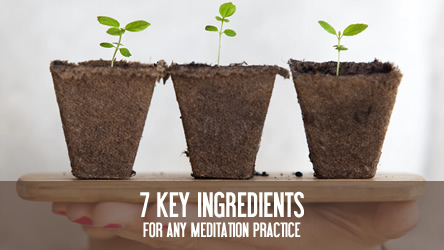Have you ever gone out on a Sunday morning, returned home with a gorgeous pot plant, and then watched as it slowly withered away and died over the coming weeks?
Perhaps no one ever told you that a plant, like a pet, needs more care and attention than you’d assumed.
A meditation practice can be a bit like this too.
Say you’ve downloaded an app and been meditating enthusiastically for a few weeks. Or perhaps you’ve recently completed a meditation course. What can you do to ensure that your practice grows into an easy, enjoyable and fruitful one?
Unfortunately, there’s no magic bullet — and no secret. But there is a recipe that can help: you can attend to your meditation practice in the same way gardeners tend to their plants.
For instance, every gardener knows that plants need:
- soil
- water
- sunlight
- fertilizer
- re-potting
- pruning
They also know that a plant needs a lot of care and attention in the early stages, and that if you look after your plant it will grow, flower and eventually bear fruit. As it grows, it becomes hardier, requires less attention, and can survive in harsher conditions.
So, when it comes to meditation, what are the equivalents?
The foundation — or soil — for any meditation practice, is practice.
Without practice your meditation habit doesn’t have a chance. That doesn’t mean you have to go all gung ho and sit in the same time and place every day for the rest of your life. It just means that you practice regularly. Say fifteen minutes a day, five time a week — and even this could be done in creative ways.
Now soil, of course, is essential. But it’s not sufficient. You also need water. For the meditator, water is what nourishes and inspires your practice. It could be:
- reading a paragraph or two from a meditation book before practicing
- listening to to a podcast
- attending a class
- listening to a guided meditation
- talking with a friend (about meditation)
These things prevent your practice from becoming too dry. In the same way that water allows plants to absorb nutrients from the soil, a good book or podcast instills you with fresh ideas to explore. Without them, you may find that meditation becomes stale, routine or uninteresting, and that you don’t get much from it.

So our meditation tree — really just a sapling at this stage — is doing well. Its roots have a place to grow, and it’s getting sufficient water. But is it getting the right amount of light? Some people assume that you can plonk a plant anywhere, and that it will be fine. But each plant is different. Some need full sunlight, others can survive in the shade. No plant, however, can survive in the dark.
In meditation, light is provided through journaling and reflection. You can do this by taking the time to reflect back upon a recent meditation sitting, and to make notes about what you can remember. Journaling in this fashion is a much neglected practice, but one that can make a big difference, especially if you feel confused, stuck or uncertain about what you’re doing. Looking back over your meditation allows you to glean insight and understanding from your practice. Without it, much of what you experience during meditation may remain opaque, and your most problematic habits of mind may continue to sprout like weeds in your meditation garden.
Of course, you don’t have to move your plant from place to place every day of the week. That would be a chore and an unnecessary burden. However, if your meditation plant isn’t looking too healthy, it could be time to reflect on how much light your practice is getting. Failing that, you might have to do some pruning, or find some fertilizer.
In my little horticultural analogy, the meditator’s fertlizer is a teacher, and pruning is what the teacher does; helping to shape your practice so that it grows in the optimal way.
With each of these ingredients your meditation ‘tree’ has a good chance of thriving. However, sometimes it might wilt despite your best efforts. Under such circumstances it may require something more; the perfect conditions a greenhouse affords.
For the meditator, such ideal conditions can be found on retreat, the best place to go if you want your meditation practice to thrive (or to recover, if it’s suffering).
So now you know what’s required in order to establish a health meditation practice (and what to do if your pot plants keep dying).
Keep in mind that you’ll need to give your young practice lots of care and attention — and that if you do, it will eventually care for you.


